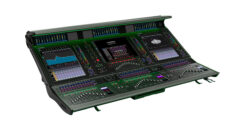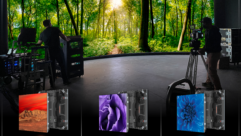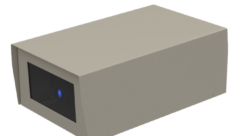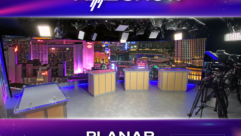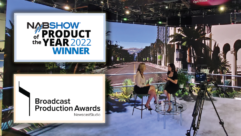https://soundcloud.com/user-442285304/the-svc-podcast-216
SVC Podcast – Show Notes – Show 216
On this edition of the SVC Podcast, Contributing Editor Bennett Liles talks with Les Goldberg, author and CEO of Entertainment Technology Partners about video display technology for live events, including corporate and touring video setup and operation. Les provides a fresh backdrop on current video formats and he presents some interesting behind the scenes details on what it takes to make immersive 4K Ultra HD video, sound and lighting possible on location.
Links of Interest:
· The home web site for Les Goldberg
· LMG – offering support for show technology, systems integration and touring
· Entertainment Technology Partners website
· Les Goldberg’s Book on Amazon
· Follow LMG Touring’s Instagram
This is the SVC Podcast from Sound & Video Contractor with Les Goldberg of Entertainment Technology Partners. We’ve got all the show notes and product links for the podcasts at svconline.com. Go to Podcasts at the top of the page.
Handling lights, video and sound for live events can have you walking a tightrope but when a job is well done it’s an immense feeling of satisfaction. Les Goldberg has done it all for corporate and touring events and he’s here to tell us what it’s like living right on the edge when a live show is on the line. That’s coming up right now on the SVC Podcast.
Les, thanks for getting with us on the SVC Podcast from Orlando. I’ve enjoyed your articles in Sound & Video Contractor for a long time and it’s great to be finally talking to you in person.
Well, it’s good to be on your podcast today.
Alright and we’re going to be discussing what you do which involves a lot of video display technology for live events, both touring and corporate. That can either be a nightmare job or one that you get a big kick out of and I’m sure you’ve had both experiences. So tell us what you’ve been doing lately on video for live events with Entertainment Technology Partners and LMG.
LMG is a 35-yearr-old company that I started – we started as a video company. And it started as a video projector, a 3CRG projector 35 years ago and video has come a long way since then. And we’ve become a full service company with video, audio and lighting and LED, but I’ll focus on the video components. You know, video has come of age and it’s evolved so much in the last 10 years – almost more than it did the last 25 years. So with visual display, we lived in the world where big projected images were beautiful and it had something to do with resolution and brightness and large screens. We showed the software demo or the content was on these big, vivid screens. And then magically about 10 years ago, the LED world kind of changed. It went from being heavy, expensive, inflexible and the LED world came of age and we got better images out of it. And the costs went down and the manufacturing in China made it more affordable. And what ultimately happened is we started to invest in LED and that business kind of grew, in a sense, for demand. There’s a lot of shows in high-res LED which allowed us to have competing technologies for large display. So you had the projection in some environments and you also had LED in other environments. And sometimes you have a show where we use both of them, and some shows are all projection, and then the next year they come back and they’re all LED.
And combined with that you had the resolution in the signal path going from RGB to HD to 3G to 4K. And then you have multihead card displays, and then you had screens that got crazy big with multiple stacks of projection display where there’s blended images and scaling. And the LED world, to compete, it became these massive screens and we dealt with having to buy enough of an LED product so you didn’t have to have batch problems. So the wild world of display has grown and it’s literally something that’s kind of leading the event space. So the lighting and the audio don’t have as much of an impact, generally, as the visual display because your eyes, that’s the thing that your eyes are drawn to. And the lighting kind of supplements it, and if you can’t hear it it’s part of the magic for the audio. But I think the increased resolution, the opportunity for people to buy LED, has really made a big difference and we have something like 25,000 LED panels in our rental inventory. [Timestamp: 4:04]

That sounds like a very big investment. You’ve been in this for a long time and you’ve seen a lot of technology come and go. One of the things that comes to me when I see the word “live” is backups. What all can go wrong? I mean, what kind of backup systems are commonly used for live events in playback, signal transmission and power?
I wish I could say on the power side there were a lot of backups. Some devices use an uninterrupted power supply and we strategically put them in maybe a graphics machine. Certain things that are sensitive to power, especially things that if the power were to flicker or there would be a change in power, it might cause the unit to fail. I think more so on the, what I would refer to as the backups. You back up things within a system from the entry point of your playback device, so you generally have a playback solution whether it’s a computer or a hard drive, a tape machine – something – and then you have a backup playback machine. And at the end of the day you have to be able to do a seamless switch. So if a file gets corrupt or if the device jams or burps, so to speak, your content still gets delivered. So it’s the simultaneous roll on a device and that is one of the first elements, and then you’re sending your signal to multiple devices. And it’s not very common to run dual signal paths to many projection display devices. So we don’t backup every element of the system, but we back up what we would call the problematic ones or the ones that have been known to fail. You know, you typically would backup your display. If it’s a projector you back it up. If you had an LED wall you’d have a backup processor. So in a perfect world you have two dualing systems in a room where if one were to fail you can switch on the other one, but that’s just not pragmatic. So it’s about identifying the points of failure and coming up with a plan that you can have a primary and a backup. Typically on an audio console we have a backup power supply, so we generally don’t have a full backup console.
But within lighting we have a full backup lighting console generally. So it just depends, but systems and electronic devices can fail based on lots of reasons whether it’s age, whether it’s maintenance or it’s just one of those times where it’s going to fail. But we typically don’t do any type of general sessions where we don’t have a live, hot backup projector because our industry is very fatalistic. You get one shot to get it right and you don’t want to fail. So it’s a good measure, or what we refer to as an insurance policy. Having a backup projector or a backup wireless mic. Backups are just, in the best case scenario, they’re there for no purpose because the primaries are all going to work. But I’ve seen people either do damage to microphones or things happen unexpectedly and being able to position yourself to be successful in those moments is all about the backups.
Yes, I would think that between having live performers with their artistic temperaments mixed in with weather when you’ve got an outdoor event, it can get pretty dicey. There’s always a potential not only for failure on one of these systems but for them to actually compete with each other. Is there a type of large video display that presents the most significant challenge to lighting?
LED walls have more ability to get brighter, generally. If they’re an indoor or an outdoor one you still have more, so to speak, nits to create these large, bright displays. Projection has a little bit more limitations on how you use them because they don’t have the ability to compete in the same format as LED. And the lighting elements on a show are to light the stage. Well, the stage is generally surrounded by some type of visual element of a display whether it’s an LED wall or projection. And the idea is for the presenter to be lit. You want that light to be focused on them and not on the screen. But sometimes high ambient light environments cause havoc to the display on the screen because light can reflect off of any type of surface, whether you have a white surface or any type of object on the stage. And ultimately you’ve got to be careful about not putting any direct light on a projection screen. The LED screens can be a little bit more forgiving, but they still have the same issue. We’re dealing with light and it’s a visual stimuli and that light is something that, for us to use our cameras to record anyone, we need to have some light on them. But we don’t want that light to compete with what’s going on the projection display or on the LED walls. And that’s about good planning and good execution, and that’s where the rubber meets the road when you have lighting and video that compete. [Timestamp: 9:05]
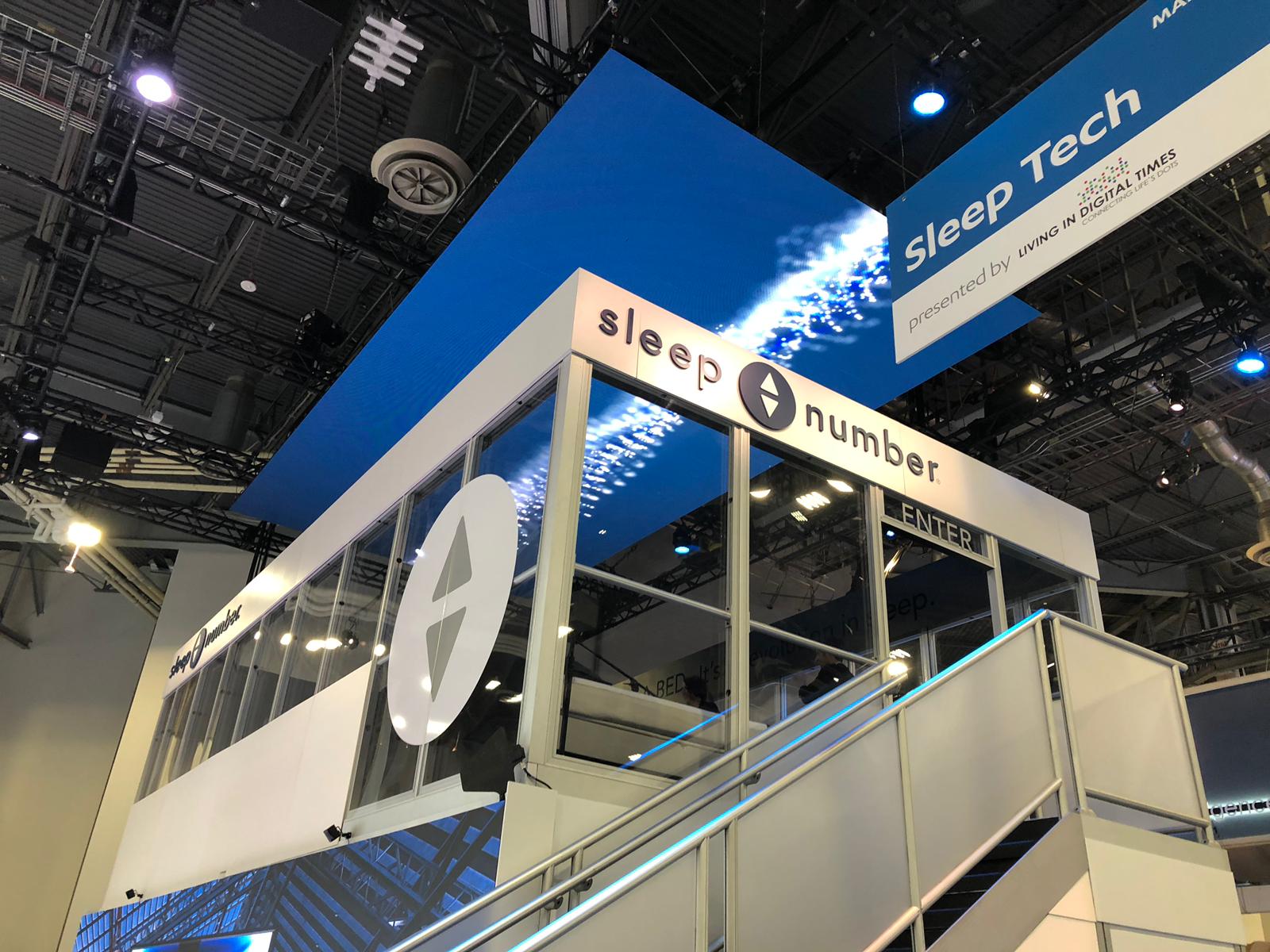
And I would think it’s simpler if you’re handling everything rather than having to work with different companies where one is doing sound, another the lighting and so on but it looks like the trend is toward one company such as yours handling all of the technical aspects.
What you’re referring to is the full service live event staging company. So the company that provides LED – the lights and sound, the visual media – all of that in one kind of one stop shop. And that works very commonly for many, many shows. And it’s really about the production team having a comfort level with the company; the ability to deliver this really high-end, high quality service among all disciplines. And I’ll tell you where that formula kind of is different. That is different when you have a show that requires a thousand moving lights and when you get to scale not all the companies can deliver at scale for super large events. So that’s kind of the differentiation. And also sometimes the projection team might have a relationship with a certain type of provider, whether it be a lighting provider, an audio provider or an LED provider where they just want to use that one component through a specialty lighting-only company versus a full service company. So I find the formula is we generally do the medium shows – so the smaller shows we are providing everything. And sometimes when we get into scale for the super large shows there might be a provider that just does one of the elements. [Timestamp: 10:38]
I’m not sure how common this is but are there shows that you work on that have multi-site interaction on a live event?
Yes. We have many, many shows actually. You know, there’s a couple of types of shows to consider when you talk about that interaction. You have the idea where there’s a remote presenter and that remote presenter is going to come in from a foreign city and we’re going to bring him in via video conference or via Skype – via one of the many ways you can bring someone in virtually – and we do a two-way interactive kind of scenario where they see us and we see them. It’s literally almost like a television interview you see on broadcast with a remote person. So that’s one version of how there’s a remote environment that’s interacting with a general session somewhere. And then kind of the bigger aspect of doing this is to have two massive general sessions. We’ve done this multiple times in Las Vegas where we have so many people that they have to go into two different venues – like the MGM Grand Garden Arena and maybe the event center at the Mandalay Bay – and we run fiber between the two venues and we literally switch back and forth between presentations. And so a presenter can be in one venue or the other venue and they can actually be presenting to the live audience, whether the audience is in either venue. And ultimately with fiber you don’t have to worry about a lot of delay, but if we go to satellite or other technologies to encode the signal and send it we may have to deal with the delay issues.
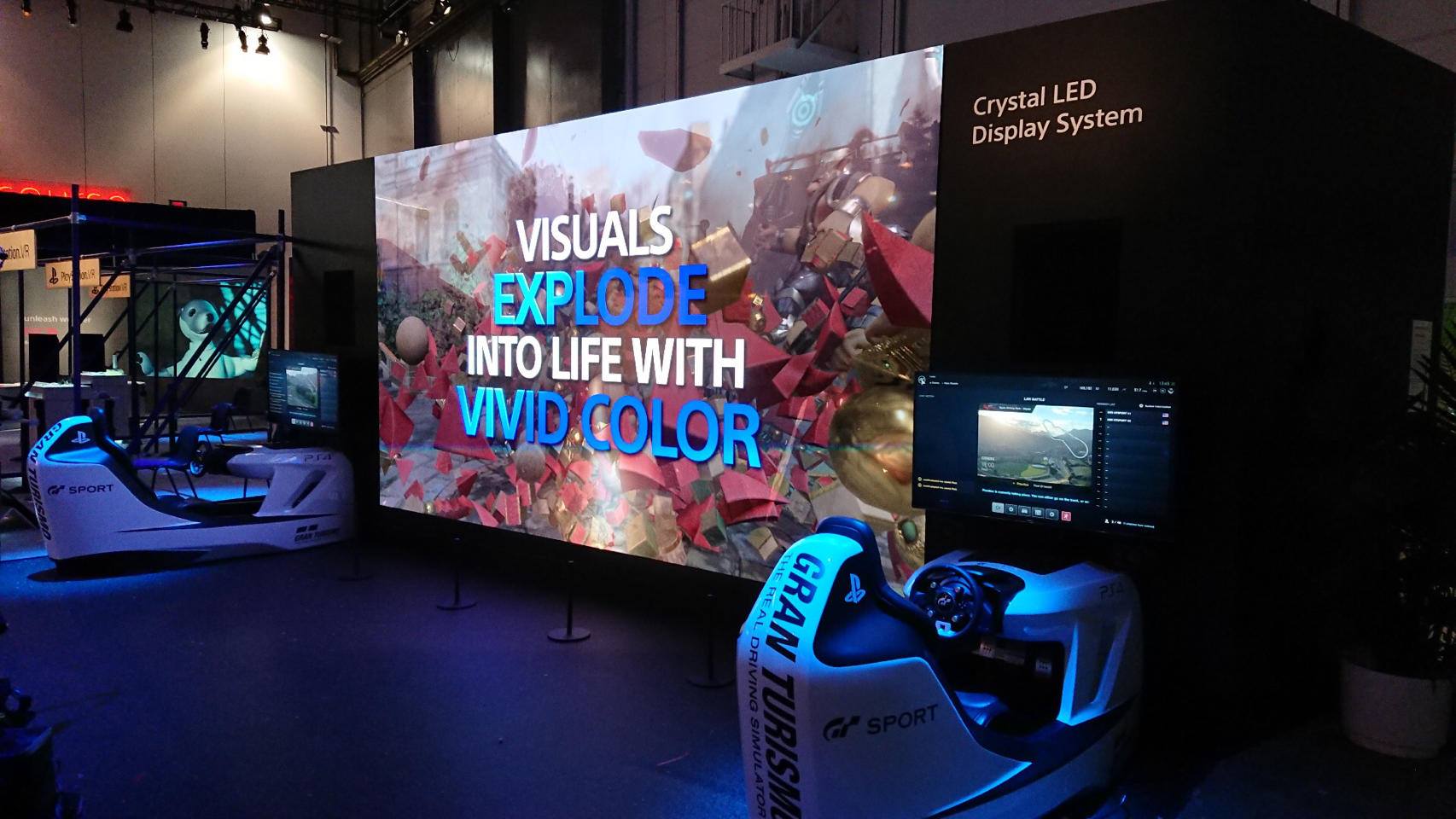
But this live interactive thing, you know sometimes we even do holograms where we bring someone in remotely with a hologram. The key element of that is timing. It’s about how the set works and how it all looks because we want to make sure someone looks real. But I’m thinking the concept of the simple two-screen show, which we did 10 years ago – so the kind of shows we’re doing now, while they still are the simple two-screen shows, but the idea with technology is we’re bringing people in and we’re using and leveraging all this cool technology to try to make more audience interactive engaging experiences. And when you bring people in virtually that tends to help you deliver that in a very meaningful way. [Timestamp: 12:53]
I know there’s a lot to it. You’ve done video, lighting and sound for corporate events and for live tours and there must be significant differences between doing those two types of jobs.
Absolutely. A tour is something we take on the road for some period of time – weeks, months, even years for some – and it’s got to be packaged in a way that you can load a tour in, not days in hours because you generally get the venue with your touring artists for that day. And when you load in it’s got to all be packaged so it can go in off the truck and fly and be ready to set up very, very quickly. And a corporate event we generally have a little bit more time and the packaging doesn’t have to have that same level of – almost like a race team where they change the tires. It goes in and generally there’s a setup day, maybe there’s a production rehearsal day, and then you’re going to client rehearsals and show. So it depends on the scale, but the fundamental difference is not necessarily in the type of gear. Either it’s packaged or when we start doing a large arena tour, the first couple of tour dates we’re kind of figuring out exactly the best way to load it in and load it out. And what happens it after the first couple of events, the performance gets better and we perfect how we’re going to do it the most meaningful, timely way. And usually by the second or third week it’s like a race team and they’re changing those tires and they know exactly how to do it because they’re striking in one venue and going on the truck and they have to immediately drive to the next venue and only hours later set the same equipment up. So it’s the least number of connections and the best packaging makes a huge difference on the touring side. And corporate, obviously we’re generally not dealing with a musical artist unless they’re coming in for a specialty night and in corporate it’s about these methodical presentations that a lot of times corporate executives want to rehearse and they want to get people in an environment where it really works for the audience. It’s more of a fine-tuned experience for that specific audience whereas the musical touring, we’re going to many, many different types of venues that have all different types of attributes. [Timestamp: 5:13]
And one of the most crucial parts of these shows that’s best if it remains behind the scenes is technical communication during the show. What’s the biggest challenge for communication between the tech people?
There’s a creative concept and there’s content that’s produced and that content gets played back at very specific times. And those times it gets played back on cue, it’s all about trying to make sure that the message is delivered at the exact right time. So timing is very important. Now we typically have a wired intercom solution. Sometimes we have a multichannel wired intercom solution, like a Riedel system. Sometimes we have a lot of wireless headsets and we’re dealing with how much area from backstage to front of house. Sometimes there’s multiple rooms and with new digital intercoms you don’t even have to be in the same building and you can log in and listen and participate with communication and that set of people that are working with headsets on that are communicating to make sure everyone knows what their cues are and they act accordingly. And I think typically before a live event there’s a production meeting and expectations are set by the department heads and the people – the techs – that are pushing the buttons. And the best success is when people realize what is expected out of them and they get good direction from a show caller or a director who is trying to make something happen. Sometimes we do use opening modules and closing modules where there’s timecode or midi that cues other devices. We have a multiscreen kind of show where things have to happen really to the beat of the music, or there could be something flying in or a reveal happening. So I think at the end of the day making sure that people can be heard. In some environments where they’re real loud our camera guys wear double headsets – the double-muff headsets. But it’s making sure that there’s a plan, everyone understands the plan. And also sometimes things don’t go exactly as planned and then what happens is the communication becomes even more essential because we have to kind of go with the flow. Especially for live events, coming up with real solutions or making changes based on what happens onstage. And so not every presenter will follow the program or the teleprompter. [Timestamp: 17:51]
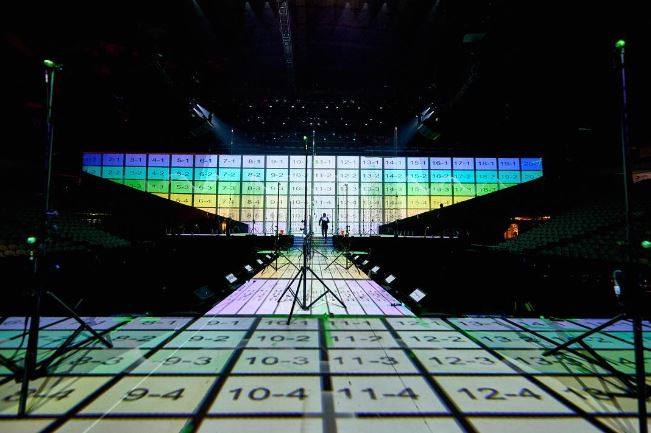
Yes, that’s always a big “IF” on live things when people on camera can be nervous and get flustered. We all know how many things can go wrong but I’d like to flip that around and ask what are the most fun live gigs that you’ve had?
When you say fun that can mean a lot of different things. Fun can be the ones that were the most challenging. Fun could also mean the ones that looked the coolest. And fun can also be the ones that you stressed out the most over, right? But I think where I get jazzed about doing live events is when we create something called spectacle. When it’s not the typical two or three screen show with drape and some downstage monitors and a podium. I like when there’s multiple elements of the show and a lot of things have to come together for us to really put something together we would call spectacle or high-end production. And it can be scaled. It doesn’t matter if it’s 100 people or 100,000 people. The idea of doing something fun is where someone comes up with a vision and we all shake our head and go, “Hmm.” And in the end we walk into a convention center, an arena, and we look up at the screens and we shake our head and go, “Wow, that’s amazing.” So my definition of a fun live gig is something that creates an a-ha moment, so those moments that are created where people feel like it evokes some kind of emotion and you know you’re experiencing something special. And that could be everything to some of the big super high-end corporate events we do, because some of the coolest entertainment events. I think the entertainment events are a little sexier because you’re dealing with artists that some people feel some level of devotion or they’re big fans of that artist’s work – the music. And corporate events, it’s about that big product reveal. It’s about demonstrating something super cool that’s never happened. I can recall about 10 years ago when telepresence was being launched by Cisco, and I can remember being there. And at the time I didn’t realize, but that became ultimately one of the coolest things that Cisco builds. They have the telepresence rooms and video conferencing really came of age. And sometimes you’re in the middle of it and don’t even realize what’s happening and they’re revealing the future. I think those are the kind of events that get your blood pumping. And also the ones that challenge you, we just did an event in Las Vegas. We did an event where we put an LED ceiling in. It was a bed manufacturer and you lied on the bed and you looked up at the ceiling and they told the story – and you’re sitting in bed. It’s that kind of stuff that is fun to do. When people come and challenge you technically and to work within some environments that may not be conducive of what we need to do and we’re able to deliver that show and really meet or exceed the vision of the creative person, that’s what jazzes me. Also being able to use the latest and greatest technology with 4K cameras and 4K projection, the newest, latest media servers and all this cool stuff, that is where we get to have a lot of fun. But live events are not for everyone. If you don’t like to have that pitter-patter of your heart beating hoping things go exactly as planned and you get one shot to get it right, and it not necessarily gives you the outcome you want but it’s the one you have to live with. [Timestamp: 21:20]
There are so many things involved, those live events must be something like conducting an orchestra. It’s always interesting to hear about how it all comes together and it’s been great listening to you describe it from the inside. We’ve been talking to Les Goldberg, CEO of Entertainment Technology Partners and LMG with show technology, systems integration and touring. Certainly a job that keeps you hopping and we’ve enjoyed hearing about it.
People ask me, “When was your last boring day?” We don’t have any of those. We live in this world of adventure and we keep on trucking, trying to keep the show mentality of the show must go on and deliver the best show humanly possible every single day. And it doesn’t matter if it’s a small or a large one, there’s always an audience. And I think if you go to the movies there’s a little acronym that says the audience is listening. I would say the audience is not only listening, they’re watching too. [Timestamp: 22:19]
Great hearing about it and good luck, Les.
All right. Thank you so much.
Video, lighting and sound on live events can be very stressful and at the same time incredibly rewarding. Thanks to Les for giving us a closer look at what it takes to make it all work in corporate and touring situations where it has to be right the first time. Join us for more AV technology and installation stories on the next SVC Podcast.


